Negligence Analysis: Tamara vs. Aldi Supermarket - BUS107
VerifiedAdded on 2022/11/14
|6
|1446
|283
Case Study
AI Summary
This assignment analyzes a negligence case involving Tamara and Aldi Supermarket, focusing on the elements of the tort of negligence. The analysis begins by establishing whether Aldi Supermarket owed Tamara a duty of care, considering the principles of foreseeability and proximity. It then assesses whether Aldi breached that duty by failing to maintain a safe environment, specifically regarding a spilt ice cream. The assignment explores the concept of causation, examining whether Aldi's actions directly led to Tamara's injury and the resulting damages. Further, the document discusses potential defenses for Aldi, such as contributory negligence, where Tamara's actions might have contributed to the injury. The assignment concludes with an assessment of the likelihood of Tamara's success in her negligence claim, considering the application of relevant legal principles and potential outcomes, while also acknowledging the possibility of shared liability due to contributory negligence.
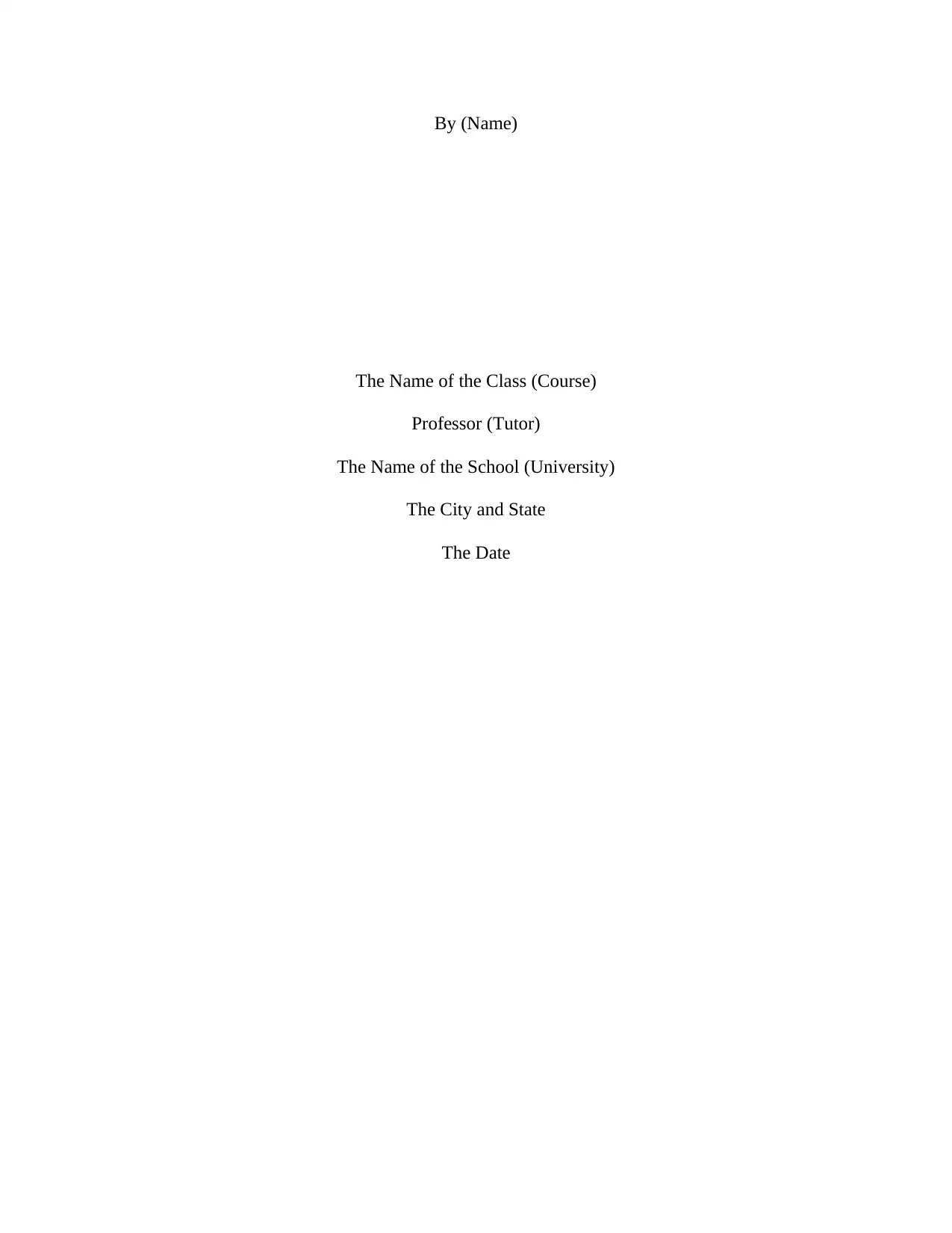
By (Name)
The Name of the Class (Course)
Professor (Tutor)
The Name of the School (University)
The City and State
The Date
The Name of the Class (Course)
Professor (Tutor)
The Name of the School (University)
The City and State
The Date
Paraphrase This Document
Need a fresh take? Get an instant paraphrase of this document with our AI Paraphraser
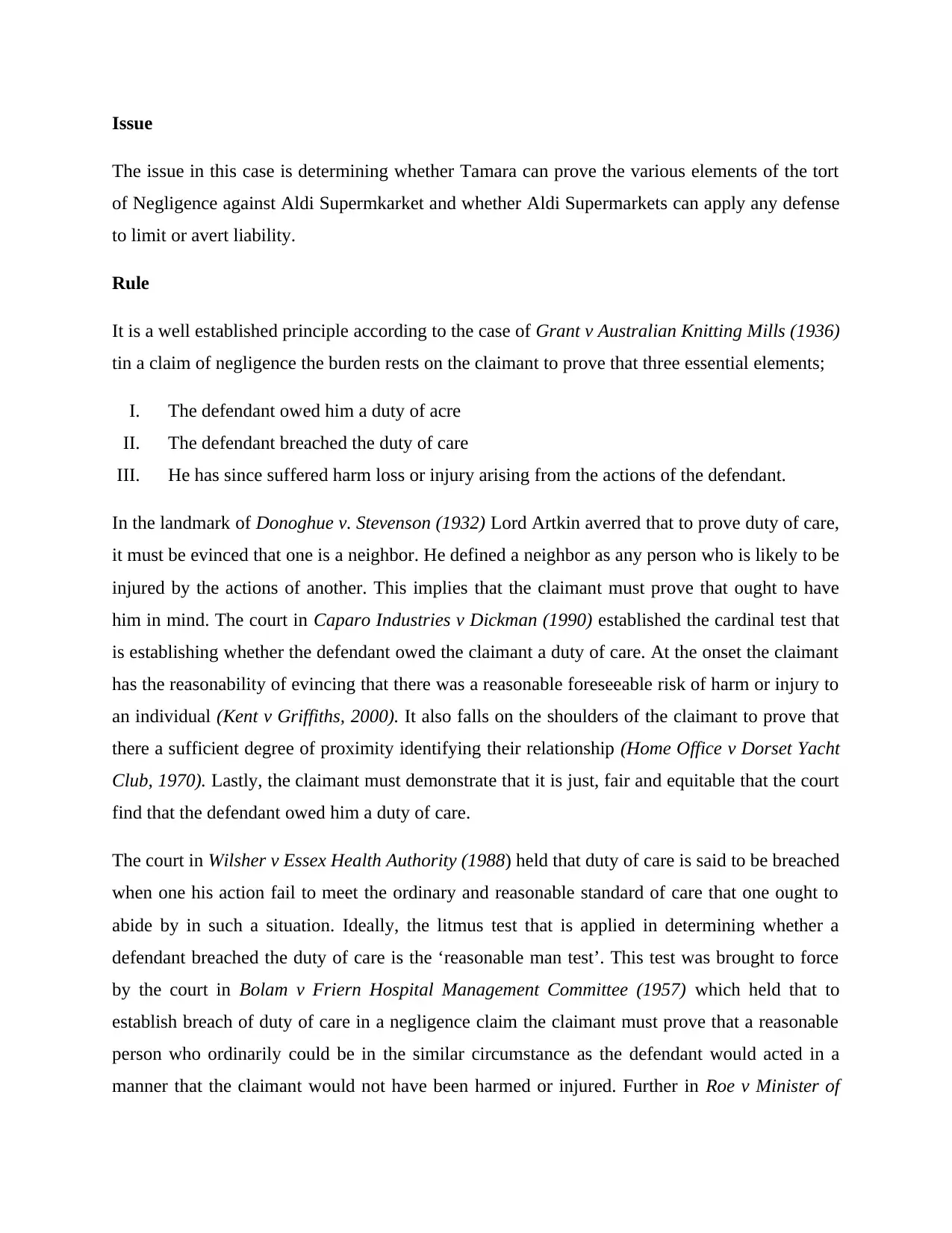
Issue
The issue in this case is determining whether Tamara can prove the various elements of the tort
of Negligence against Aldi Supermkarket and whether Aldi Supermarkets can apply any defense
to limit or avert liability.
Rule
It is a well established principle according to the case of Grant v Australian Knitting Mills (1936)
tin a claim of negligence the burden rests on the claimant to prove that three essential elements;
I. The defendant owed him a duty of acre
II. The defendant breached the duty of care
III. He has since suffered harm loss or injury arising from the actions of the defendant.
In the landmark of Donoghue v. Stevenson (1932) Lord Artkin averred that to prove duty of care,
it must be evinced that one is a neighbor. He defined a neighbor as any person who is likely to be
injured by the actions of another. This implies that the claimant must prove that ought to have
him in mind. The court in Caparo Industries v Dickman (1990) established the cardinal test that
is establishing whether the defendant owed the claimant a duty of care. At the onset the claimant
has the reasonability of evincing that there was a reasonable foreseeable risk of harm or injury to
an individual (Kent v Griffiths, 2000). It also falls on the shoulders of the claimant to prove that
there a sufficient degree of proximity identifying their relationship (Home Office v Dorset Yacht
Club, 1970). Lastly, the claimant must demonstrate that it is just, fair and equitable that the court
find that the defendant owed him a duty of care.
The court in Wilsher v Essex Health Authority (1988) held that duty of care is said to be breached
when one his action fail to meet the ordinary and reasonable standard of care that one ought to
abide by in such a situation. Ideally, the litmus test that is applied in determining whether a
defendant breached the duty of care is the ‘reasonable man test’. This test was brought to force
by the court in Bolam v Friern Hospital Management Committee (1957) which held that to
establish breach of duty of care in a negligence claim the claimant must prove that a reasonable
person who ordinarily could be in the similar circumstance as the defendant would acted in a
manner that the claimant would not have been harmed or injured. Further in Roe v Minister of
The issue in this case is determining whether Tamara can prove the various elements of the tort
of Negligence against Aldi Supermkarket and whether Aldi Supermarkets can apply any defense
to limit or avert liability.
Rule
It is a well established principle according to the case of Grant v Australian Knitting Mills (1936)
tin a claim of negligence the burden rests on the claimant to prove that three essential elements;
I. The defendant owed him a duty of acre
II. The defendant breached the duty of care
III. He has since suffered harm loss or injury arising from the actions of the defendant.
In the landmark of Donoghue v. Stevenson (1932) Lord Artkin averred that to prove duty of care,
it must be evinced that one is a neighbor. He defined a neighbor as any person who is likely to be
injured by the actions of another. This implies that the claimant must prove that ought to have
him in mind. The court in Caparo Industries v Dickman (1990) established the cardinal test that
is establishing whether the defendant owed the claimant a duty of care. At the onset the claimant
has the reasonability of evincing that there was a reasonable foreseeable risk of harm or injury to
an individual (Kent v Griffiths, 2000). It also falls on the shoulders of the claimant to prove that
there a sufficient degree of proximity identifying their relationship (Home Office v Dorset Yacht
Club, 1970). Lastly, the claimant must demonstrate that it is just, fair and equitable that the court
find that the defendant owed him a duty of care.
The court in Wilsher v Essex Health Authority (1988) held that duty of care is said to be breached
when one his action fail to meet the ordinary and reasonable standard of care that one ought to
abide by in such a situation. Ideally, the litmus test that is applied in determining whether a
defendant breached the duty of care is the ‘reasonable man test’. This test was brought to force
by the court in Bolam v Friern Hospital Management Committee (1957) which held that to
establish breach of duty of care in a negligence claim the claimant must prove that a reasonable
person who ordinarily could be in the similar circumstance as the defendant would acted in a
manner that the claimant would not have been harmed or injured. Further in Roe v Minister of
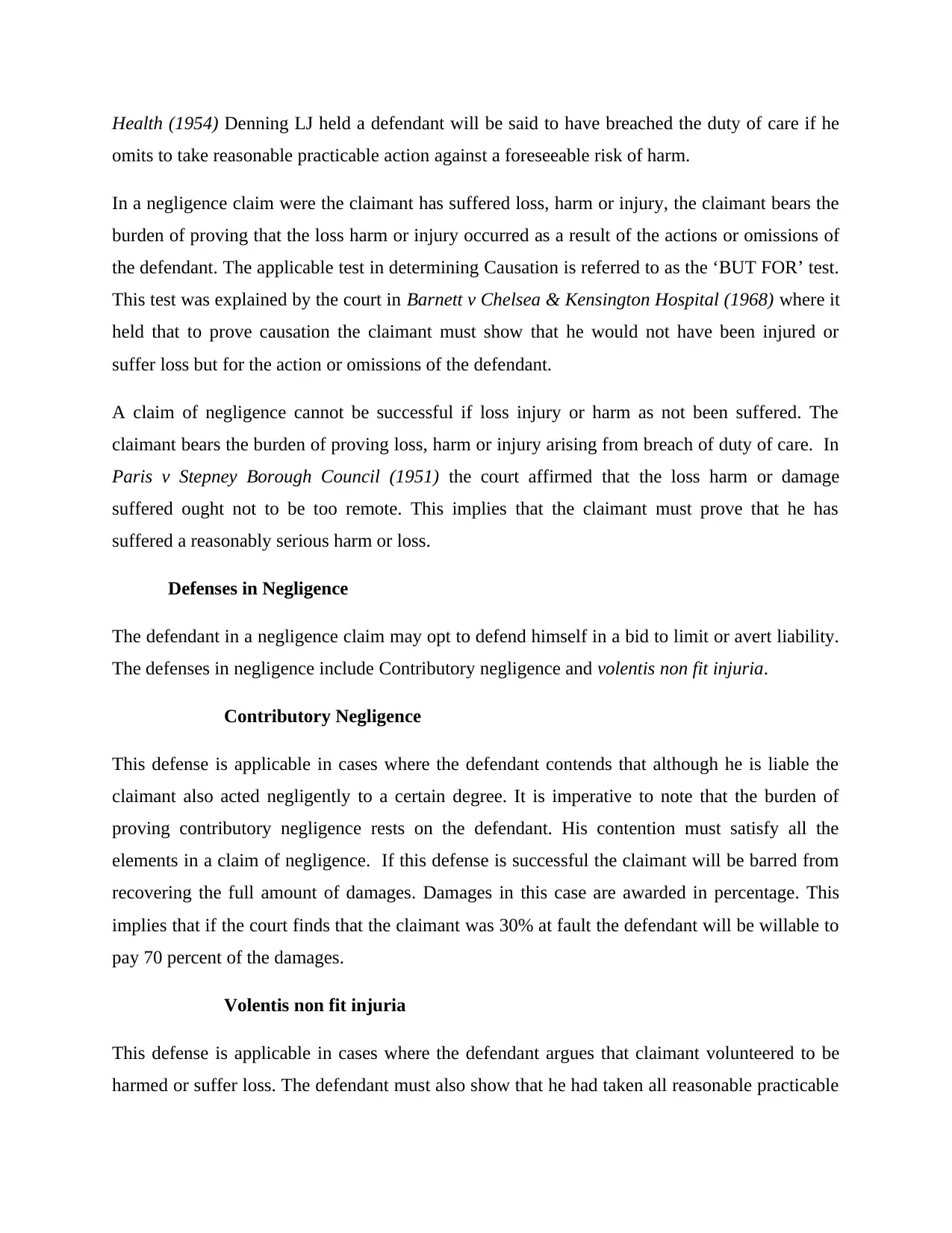
Health (1954) Denning LJ held a defendant will be said to have breached the duty of care if he
omits to take reasonable practicable action against a foreseeable risk of harm.
In a negligence claim were the claimant has suffered loss, harm or injury, the claimant bears the
burden of proving that the loss harm or injury occurred as a result of the actions or omissions of
the defendant. The applicable test in determining Causation is referred to as the ‘BUT FOR’ test.
This test was explained by the court in Barnett v Chelsea & Kensington Hospital (1968) where it
held that to prove causation the claimant must show that he would not have been injured or
suffer loss but for the action or omissions of the defendant.
A claim of negligence cannot be successful if loss injury or harm as not been suffered. The
claimant bears the burden of proving loss, harm or injury arising from breach of duty of care. In
Paris v Stepney Borough Council (1951) the court affirmed that the loss harm or damage
suffered ought not to be too remote. This implies that the claimant must prove that he has
suffered a reasonably serious harm or loss.
Defenses in Negligence
The defendant in a negligence claim may opt to defend himself in a bid to limit or avert liability.
The defenses in negligence include Contributory negligence and volentis non fit injuria.
Contributory Negligence
This defense is applicable in cases where the defendant contends that although he is liable the
claimant also acted negligently to a certain degree. It is imperative to note that the burden of
proving contributory negligence rests on the defendant. His contention must satisfy all the
elements in a claim of negligence. If this defense is successful the claimant will be barred from
recovering the full amount of damages. Damages in this case are awarded in percentage. This
implies that if the court finds that the claimant was 30% at fault the defendant will be willable to
pay 70 percent of the damages.
Volentis non fit injuria
This defense is applicable in cases where the defendant argues that claimant volunteered to be
harmed or suffer loss. The defendant must also show that he had taken all reasonable practicable
omits to take reasonable practicable action against a foreseeable risk of harm.
In a negligence claim were the claimant has suffered loss, harm or injury, the claimant bears the
burden of proving that the loss harm or injury occurred as a result of the actions or omissions of
the defendant. The applicable test in determining Causation is referred to as the ‘BUT FOR’ test.
This test was explained by the court in Barnett v Chelsea & Kensington Hospital (1968) where it
held that to prove causation the claimant must show that he would not have been injured or
suffer loss but for the action or omissions of the defendant.
A claim of negligence cannot be successful if loss injury or harm as not been suffered. The
claimant bears the burden of proving loss, harm or injury arising from breach of duty of care. In
Paris v Stepney Borough Council (1951) the court affirmed that the loss harm or damage
suffered ought not to be too remote. This implies that the claimant must prove that he has
suffered a reasonably serious harm or loss.
Defenses in Negligence
The defendant in a negligence claim may opt to defend himself in a bid to limit or avert liability.
The defenses in negligence include Contributory negligence and volentis non fit injuria.
Contributory Negligence
This defense is applicable in cases where the defendant contends that although he is liable the
claimant also acted negligently to a certain degree. It is imperative to note that the burden of
proving contributory negligence rests on the defendant. His contention must satisfy all the
elements in a claim of negligence. If this defense is successful the claimant will be barred from
recovering the full amount of damages. Damages in this case are awarded in percentage. This
implies that if the court finds that the claimant was 30% at fault the defendant will be willable to
pay 70 percent of the damages.
Volentis non fit injuria
This defense is applicable in cases where the defendant argues that claimant volunteered to be
harmed or suffer loss. The defendant must also show that he had taken all reasonable practicable
⊘ This is a preview!⊘
Do you want full access?
Subscribe today to unlock all pages.

Trusted by 1+ million students worldwide
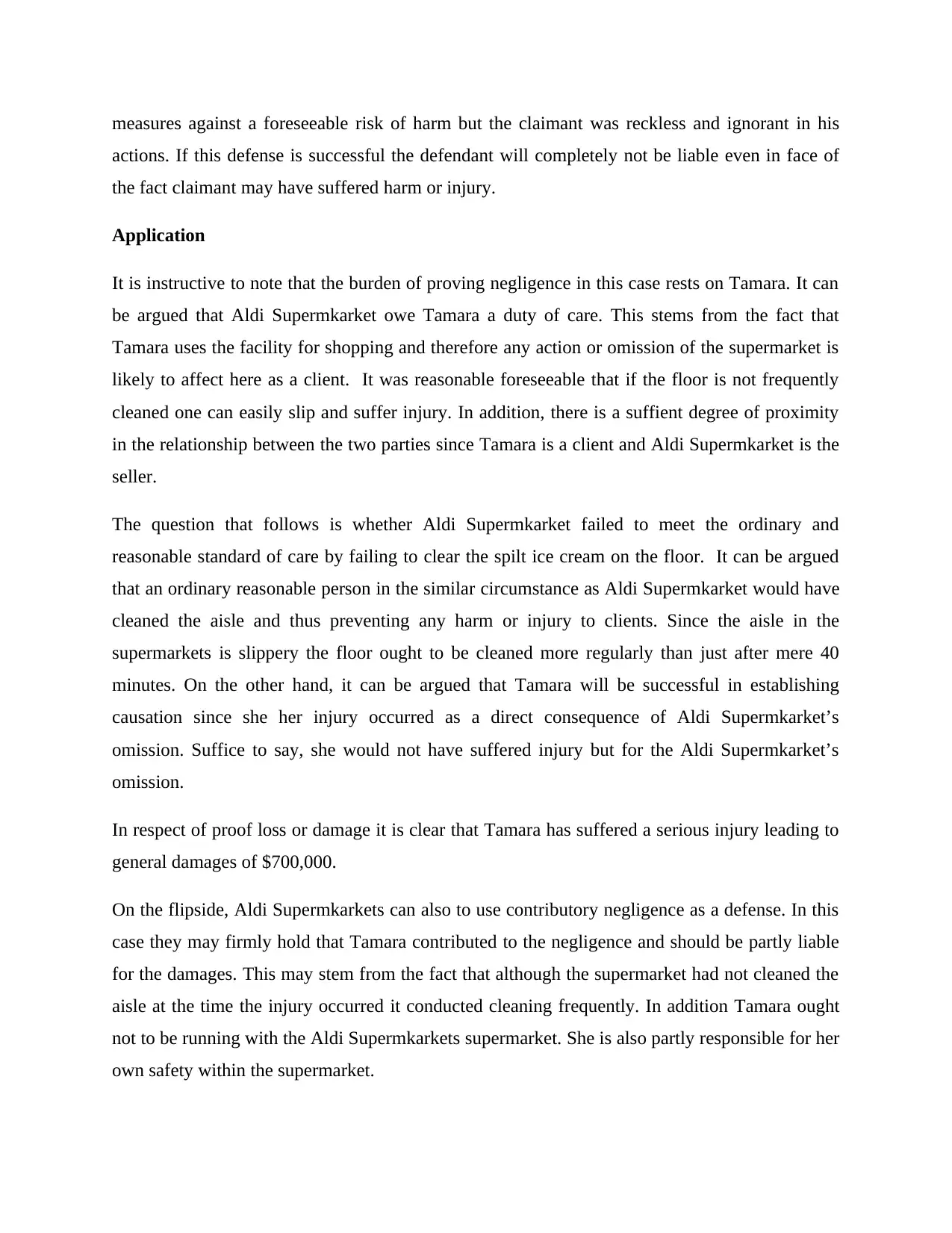
measures against a foreseeable risk of harm but the claimant was reckless and ignorant in his
actions. If this defense is successful the defendant will completely not be liable even in face of
the fact claimant may have suffered harm or injury.
Application
It is instructive to note that the burden of proving negligence in this case rests on Tamara. It can
be argued that Aldi Supermkarket owe Tamara a duty of care. This stems from the fact that
Tamara uses the facility for shopping and therefore any action or omission of the supermarket is
likely to affect here as a client. It was reasonable foreseeable that if the floor is not frequently
cleaned one can easily slip and suffer injury. In addition, there is a suffient degree of proximity
in the relationship between the two parties since Tamara is a client and Aldi Supermkarket is the
seller.
The question that follows is whether Aldi Supermkarket failed to meet the ordinary and
reasonable standard of care by failing to clear the spilt ice cream on the floor. It can be argued
that an ordinary reasonable person in the similar circumstance as Aldi Supermkarket would have
cleaned the aisle and thus preventing any harm or injury to clients. Since the aisle in the
supermarkets is slippery the floor ought to be cleaned more regularly than just after mere 40
minutes. On the other hand, it can be argued that Tamara will be successful in establishing
causation since she her injury occurred as a direct consequence of Aldi Supermkarket’s
omission. Suffice to say, she would not have suffered injury but for the Aldi Supermkarket’s
omission.
In respect of proof loss or damage it is clear that Tamara has suffered a serious injury leading to
general damages of $700,000.
On the flipside, Aldi Supermkarkets can also to use contributory negligence as a defense. In this
case they may firmly hold that Tamara contributed to the negligence and should be partly liable
for the damages. This may stem from the fact that although the supermarket had not cleaned the
aisle at the time the injury occurred it conducted cleaning frequently. In addition Tamara ought
not to be running with the Aldi Supermkarkets supermarket. She is also partly responsible for her
own safety within the supermarket.
actions. If this defense is successful the defendant will completely not be liable even in face of
the fact claimant may have suffered harm or injury.
Application
It is instructive to note that the burden of proving negligence in this case rests on Tamara. It can
be argued that Aldi Supermkarket owe Tamara a duty of care. This stems from the fact that
Tamara uses the facility for shopping and therefore any action or omission of the supermarket is
likely to affect here as a client. It was reasonable foreseeable that if the floor is not frequently
cleaned one can easily slip and suffer injury. In addition, there is a suffient degree of proximity
in the relationship between the two parties since Tamara is a client and Aldi Supermkarket is the
seller.
The question that follows is whether Aldi Supermkarket failed to meet the ordinary and
reasonable standard of care by failing to clear the spilt ice cream on the floor. It can be argued
that an ordinary reasonable person in the similar circumstance as Aldi Supermkarket would have
cleaned the aisle and thus preventing any harm or injury to clients. Since the aisle in the
supermarkets is slippery the floor ought to be cleaned more regularly than just after mere 40
minutes. On the other hand, it can be argued that Tamara will be successful in establishing
causation since she her injury occurred as a direct consequence of Aldi Supermkarket’s
omission. Suffice to say, she would not have suffered injury but for the Aldi Supermkarket’s
omission.
In respect of proof loss or damage it is clear that Tamara has suffered a serious injury leading to
general damages of $700,000.
On the flipside, Aldi Supermkarkets can also to use contributory negligence as a defense. In this
case they may firmly hold that Tamara contributed to the negligence and should be partly liable
for the damages. This may stem from the fact that although the supermarket had not cleaned the
aisle at the time the injury occurred it conducted cleaning frequently. In addition Tamara ought
not to be running with the Aldi Supermkarkets supermarket. She is also partly responsible for her
own safety within the supermarket.
Paraphrase This Document
Need a fresh take? Get an instant paraphrase of this document with our AI Paraphraser
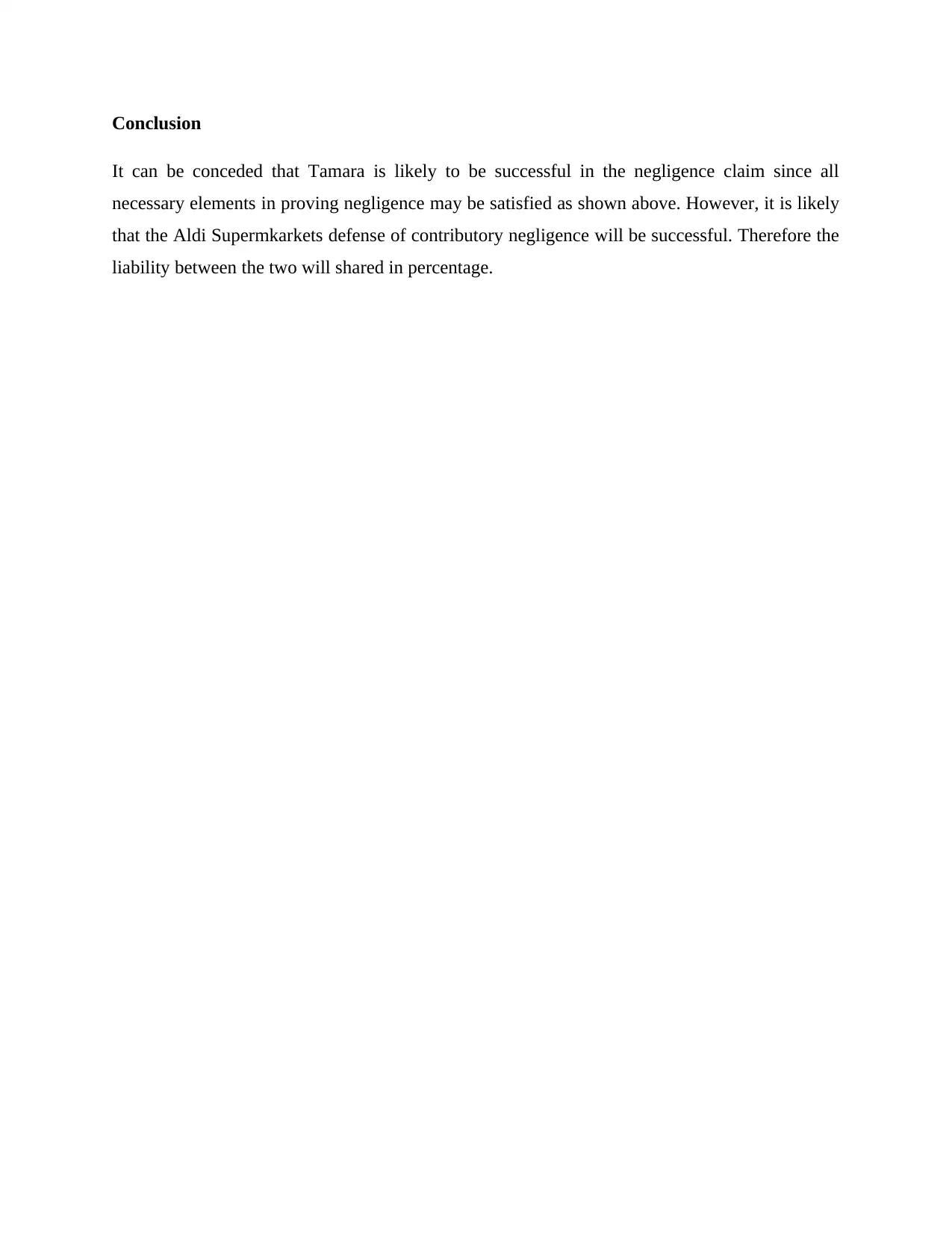
Conclusion
It can be conceded that Tamara is likely to be successful in the negligence claim since all
necessary elements in proving negligence may be satisfied as shown above. However, it is likely
that the Aldi Supermkarkets defense of contributory negligence will be successful. Therefore the
liability between the two will shared in percentage.
It can be conceded that Tamara is likely to be successful in the negligence claim since all
necessary elements in proving negligence may be satisfied as shown above. However, it is likely
that the Aldi Supermkarkets defense of contributory negligence will be successful. Therefore the
liability between the two will shared in percentage.
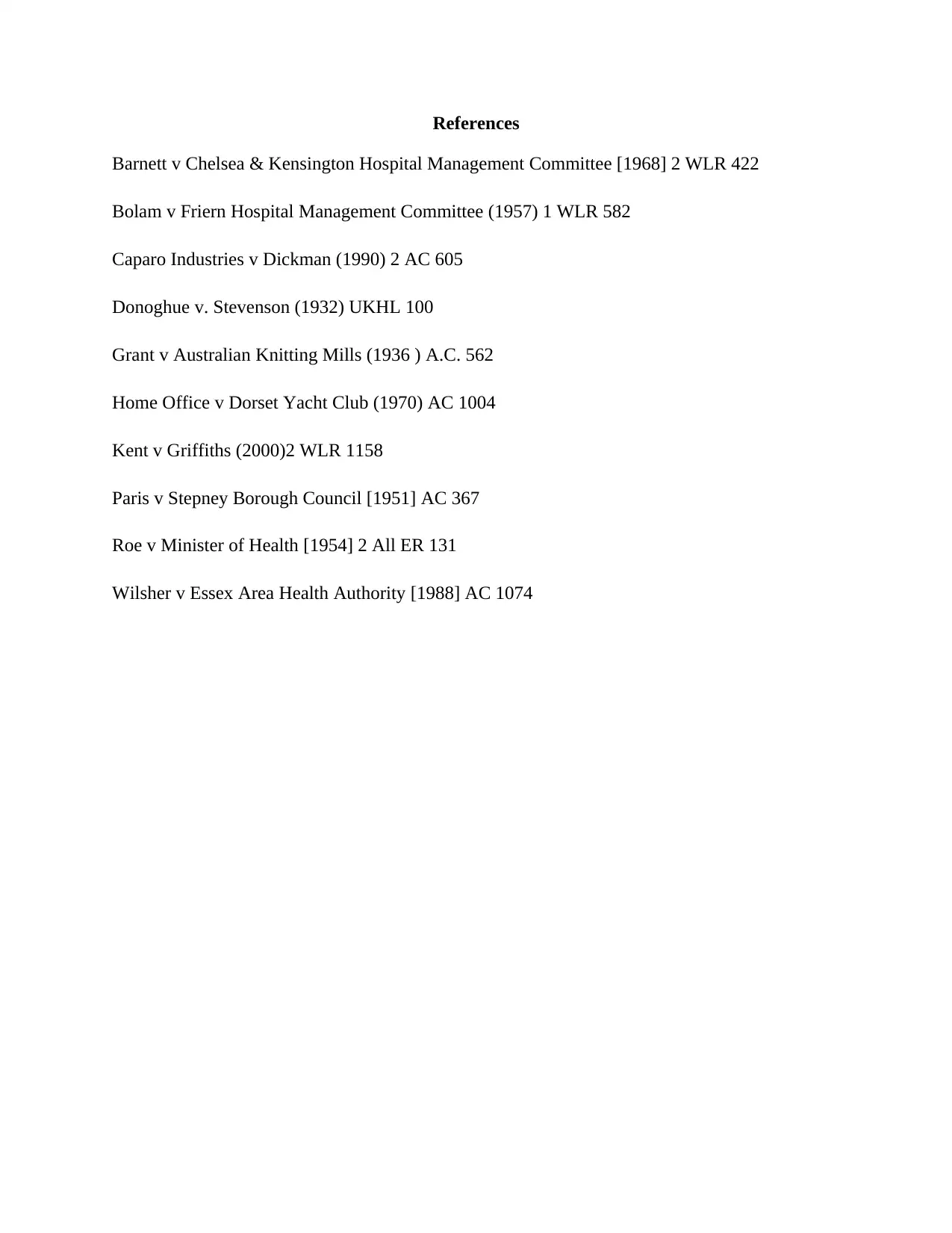
References
Barnett v Chelsea & Kensington Hospital Management Committee [1968] 2 WLR 422
Bolam v Friern Hospital Management Committee (1957) 1 WLR 582
Caparo Industries v Dickman (1990) 2 AC 605
Donoghue v. Stevenson (1932) UKHL 100
Grant v Australian Knitting Mills (1936 ) A.C. 562
Home Office v Dorset Yacht Club (1970) AC 1004
Kent v Griffiths (2000)2 WLR 1158
Paris v Stepney Borough Council [1951] AC 367
Roe v Minister of Health [1954] 2 All ER 131
Wilsher v Essex Area Health Authority [1988] AC 1074
Barnett v Chelsea & Kensington Hospital Management Committee [1968] 2 WLR 422
Bolam v Friern Hospital Management Committee (1957) 1 WLR 582
Caparo Industries v Dickman (1990) 2 AC 605
Donoghue v. Stevenson (1932) UKHL 100
Grant v Australian Knitting Mills (1936 ) A.C. 562
Home Office v Dorset Yacht Club (1970) AC 1004
Kent v Griffiths (2000)2 WLR 1158
Paris v Stepney Borough Council [1951] AC 367
Roe v Minister of Health [1954] 2 All ER 131
Wilsher v Essex Area Health Authority [1988] AC 1074
⊘ This is a preview!⊘
Do you want full access?
Subscribe today to unlock all pages.

Trusted by 1+ million students worldwide
1 out of 6
Related Documents
Your All-in-One AI-Powered Toolkit for Academic Success.
+13062052269
info@desklib.com
Available 24*7 on WhatsApp / Email
![[object Object]](/_next/static/media/star-bottom.7253800d.svg)
Unlock your academic potential
Copyright © 2020–2025 A2Z Services. All Rights Reserved. Developed and managed by ZUCOL.




